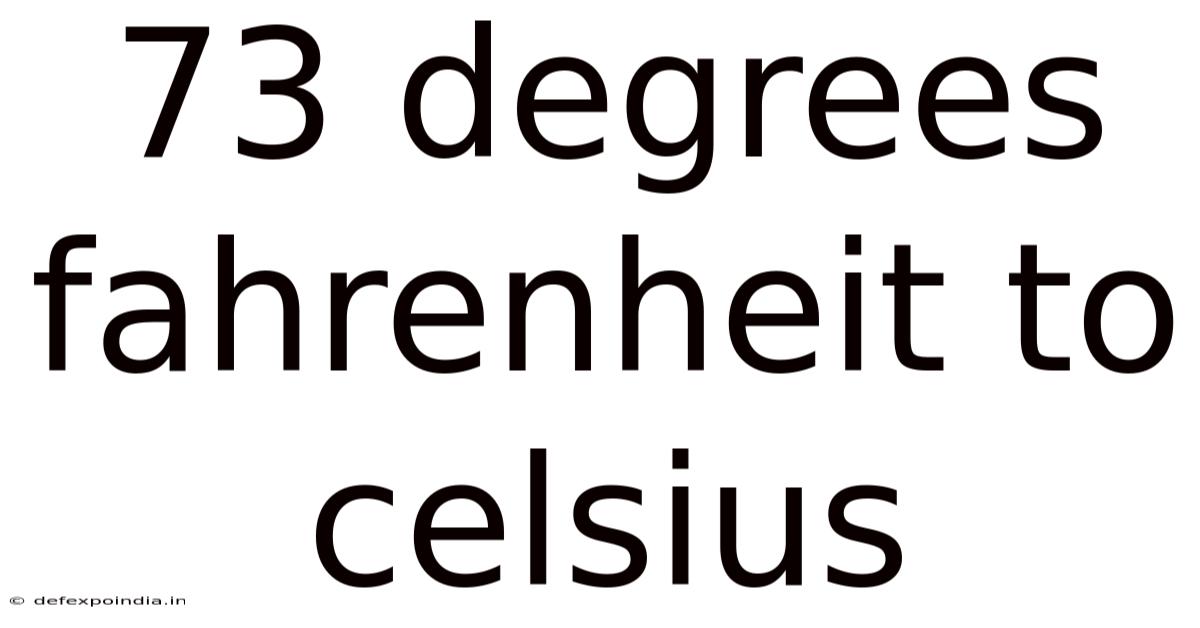73 Degrees Fahrenheit To Celsius
defexpoindia
Sep 19, 2025 · 4 min read

Table of Contents
73 Degrees Fahrenheit to Celsius: A Comprehensive Guide to Temperature Conversion
Are you wondering how to convert 73 degrees Fahrenheit to Celsius? Understanding temperature conversions is crucial in various aspects of life, from cooking and weather forecasting to scientific experiments and international travel. This comprehensive guide will not only show you how to convert 73°F to °C but also delve deeper into the underlying principles of temperature scales and provide you with practical applications and frequently asked questions. This guide will equip you with the knowledge and tools to confidently handle temperature conversions in any situation.
Understanding Fahrenheit and Celsius
Before we dive into the conversion, let's briefly understand the two most commonly used temperature scales: Fahrenheit (°F) and Celsius (°C).
-
Fahrenheit (°F): This scale was proposed by Daniel Gabriel Fahrenheit in 1724. It sets the freezing point of water at 32°F and the boiling point at 212°F, with a difference of 180 degrees between them. The Fahrenheit scale is predominantly used in the United States and a few other countries.
-
Celsius (°C): Also known as the centigrade scale, it was developed by Anders Celsius in 1742. It defines the freezing point of water at 0°C and the boiling point at 100°C, with a 100-degree difference. The Celsius scale is the standard temperature scale used worldwide for most scientific purposes and everyday life in most countries.
Converting 73 Degrees Fahrenheit to Celsius: The Formula
The conversion from Fahrenheit to Celsius involves a simple formula:
°C = (°F - 32) × 5/9
Let's apply this formula to convert 73°F:
°C = (73 - 32) × 5/9 = 41 × 5/9 = 22.777...°C
Therefore, 73 degrees Fahrenheit is approximately 22.78 degrees Celsius.
Step-by-Step Conversion of 73°F to °C
To make the conversion process clearer, let's break it down into steps:
-
Subtract 32 from the Fahrenheit temperature: 73°F - 32°F = 41°F
-
Multiply the result by 5: 41°F × 5 = 205
-
Divide the result by 9: 205 / 9 = 22.777...°C
-
Round to the desired decimal place: Rounding to two decimal places, we get 22.78°C.
The Science Behind the Conversion
The conversion formula isn't arbitrary; it reflects the different scales and the relationship between the freezing and boiling points of water in each scale. The factor 5/9 accounts for the different sizes of the degrees on the Fahrenheit and Celsius scales. The subtraction of 32 adjusts for the difference in the freezing point of water (32°F vs 0°C). The formula ensures a consistent and accurate conversion between the two systems.
Practical Applications of Temperature Conversion
Understanding temperature conversions is essential in numerous applications, including:
-
Cooking: Many recipes use either Fahrenheit or Celsius, so converting between them is crucial for accurate results.
-
Weather Forecasting: International weather reports often use Celsius, so converting from Fahrenheit is necessary for understanding local forecasts.
-
Science and Engineering: Scientific experiments and engineering designs frequently require temperature measurements in Celsius, despite initial readings potentially being in Fahrenheit.
-
Medicine: Body temperature is sometimes measured in Fahrenheit, requiring conversion to Celsius for medical records and international communication.
-
Travel: Understanding the temperature in your destination, whether reported in Fahrenheit or Celsius, helps you pack appropriate clothing and plan activities.
Frequently Asked Questions (FAQs)
Q: Why are there two different temperature scales?
A: Different scales arose historically, with Fahrenheit being developed earlier and based on different reference points. Celsius emerged later, offering a more logical and widely adopted system.
Q: Is it always necessary to round the result of the conversion?
A: The level of precision required dictates whether rounding is necessary. For most everyday purposes, rounding to one or two decimal places is sufficient. However, for scientific applications, higher precision may be required.
Q: Can I convert Celsius back to Fahrenheit?
A: Yes, the reverse conversion uses the formula: °F = (°C × 9/5) + 32
Q: Are there other temperature scales besides Fahrenheit and Celsius?
A: Yes, there are other scales, including Kelvin (K), which is an absolute temperature scale widely used in scientific contexts. Zero Kelvin represents absolute zero, the theoretical lowest possible temperature.
Q: What is the significance of 73°F?
A: 73°F (approximately 22.78°C) is a pleasant temperature for many people, often considered a comfortable room temperature or a warm spring day. Its significance lies in its frequent occurrence in everyday life and its comfortable positioning within the commonly experienced temperature range.
Conclusion: Mastering Temperature Conversion
Converting 73°F to Celsius, as demonstrated above, is a straightforward process. However, the underlying principles and practical applications are much broader. Understanding temperature scales and their conversion allows for seamless communication and accurate measurements across various disciplines and global contexts. This comprehensive guide has provided you with not only the method for converting 73°F to °C but also a solid foundation for understanding temperature conversions in general. Remember the formula, practice the steps, and you'll be proficient in converting temperatures between Fahrenheit and Celsius in no time. This knowledge will empower you to better understand and interact with the world around you.
Latest Posts
Related Post
Thank you for visiting our website which covers about 73 Degrees Fahrenheit To Celsius . We hope the information provided has been useful to you. Feel free to contact us if you have any questions or need further assistance. See you next time and don't miss to bookmark.